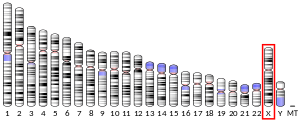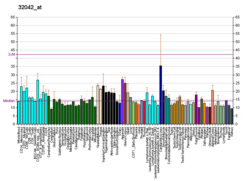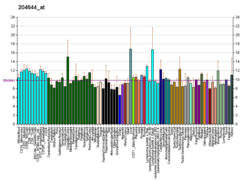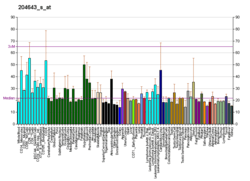ENOX2
ENOX2 is a gene located on the long arm of the X chromosome in humans.[5] The gene encodes the protein Ecto-NOX disulfide-thiol exchanger 2, a member of the NOX family of NADPH oxidases.[6][7][8]
Ecto-NOX disulfide-thiol exchanger 2 is a growth-related cell surface protein. It was identified because it reacts with the monoclonal antibody K1 in cells, such as the ovarian carcinoma line OVCAR-3, also expressing the CAKI surface glycoprotein.[6] The encoded protein has two enzymatic activities: catalysis of hydroquinone or NADH oxidation, and protein disulfide interchange. The two activities alternate with a period length of about 24 minutes. The encoded protein also displays prion-like properties. Two transcript variants encoding different isoforms have been found for this gene.[9]
Gene Location
The human ENOX2 gene is located on the long (q) arm of the X chromosome in humans, at region 2 band 6 sub band 1, from base pair 130,622,330 to 130,903,317 (build GRCh38.p7) (map). The gene is conserved in chimpanzee, Rhesus monkey, dog, mouse, rat, chicken, and zebrafish.[5]
Function
ENOX2 and related NOX proteins exhibit two distinct oscillating functions: the oxidation of NADH to NAD+ and a protein disulfide isomerase-like activity, unprecedented in the biochemical literature.[8][10][11][12] Regarding NADH oxidation, the protein has a specific activity of 10-20µmol/min/mg of protein with a turnover number of 200-500.[13][14] The oscillations are independent of temperature, with a period of 24 minutes, completing 60 cycles in a 24-hour day.[10][12] The period of oscillation changes to 22 and 26 minutes in the cancer related (tNOX) and age-related (arNOX) forms respectively.[8] This regular oscillation is attributed to the maintenance of biological clock[8][15]
Interactions
NADH activity of ENOX2 has been shown to be stimulated by various hormones and growth factors, including insulin, EGF, transferrin, lactoferrin, vasopressin and glucagon.[16] This stimulation is not seen in protein samples recovered from cancer cells, suggesting the regular NADH oxidase activity of ENOX2 is decoupled in cancer.[16] ENOX2 also has a number of protein-protein interactions, with ENOX1 and SOX2, among others.[17]
Cell Growth
Numerous studies in the 1990s correlated NADH oxidase activity with cell growth.[8] Conditions which stimulated cell growth also stimulated NADH oxidase activity and conditions that inhibited cell growth inhibited NADH oxidase activity. Further experimental evidence showed that the rate of cell enlargement oscillates within the 24 minute oscillation of ENOX function.[18] Maximum cell growth rates correspond to the portion of the ENOX cycle involved in protein dulsulfide bridge formation.[19] Theories suggest that ENOX is responsible for the breakup and formation of disulfide bonds in membrane proteins, thus maximum cell growth coincides with maximum protein disulfide interchange activity.[8]
Role In Disease
Cancer
The cancer associated, drug responsive variant of ENOX, tNOX, arises as a splice variant and is found on the cell surface of human cancers.[8][20] tNOX exhibits a periodicity of 22 minutes, compared to the native 24 minutes and can be inhibited by a number of anticancer drugs, without affecting the native ENOX.[8] These properties of tNOX are being used to develop early detection and intervention mechanisms for human cancers.[21]
See also
References
- GRCh38: Ensembl release 89: ENSG00000165675 - Ensembl, May 2017
- GRCm38: Ensembl release 89: ENSMUSG00000031109 - Ensembl, May 2017
- "Human PubMed Reference:". National Center for Biotechnology Information, U.S. National Library of Medicine.
- "Mouse PubMed Reference:". National Center for Biotechnology Information, U.S. National Library of Medicine.
- "ENOX2 ecto-NOX disulfide-thiol exchanger 2 [ Homo sapiens (human) ]". NCBI. Retrieved 2016-10-16.
- Chang K, Pastan I (May 1994). "Molecular cloning and expression of a cDNA encoding a protein detected by the K1 antibody from an ovarian carcinoma (OVCAR-3) cell line". Int J Cancer. 57 (1): 90–7. doi:10.1002/ijc.2910570117. PMID 8150545.
- Chueh PJ, Kim C, Cho N, Morre DM, Morre DJ (Mar 2002). "Molecular cloning and characterization of a tumor-associated, growth-related, and time-keeping hydroquinone (NADH) oxidase (tNOX) of the HeLa cell surface". Biochemistry. 41 (11): 3732–41. doi:10.1021/bi012041t. PMID 11888291.
- Morré, D. James; Morré, Dorothy M. (2003-08-01). "Cell surface NADH oxidases (ECTO-NOX proteins) with roles in cancer, cellular time-keeping, growth, aging and neurodegenerative diseases". Free Radical Research. 37 (8): 795–808. doi:10.1080/1071576031000083107. ISSN 1071-5762. PMID 14567438.
- "Entrez Gene: COVA1 cytosolic ovarian carcinoma antigen 1".
- Morré, D. James; Morré, Dorothy M. (1998-11-01). "NADH oxidase activity of soybean plasma membranes oscillates with a temperature compensated period of 24 min". The Plant Journal. 16 (3): 277–284. doi:10.1046/j.1365-313x.1998.00293.x. ISSN 1365-313X.
- Morré, D. J.; Chueh, P. J.; Lawler, J.; Morré, D. M. (1998-10-01). "The sulfonylurea-inhibited NADH oxidase activity of HeLa cell plasma membranes has properties of a protein disulfide-thiol oxidoreductase with protein disulfide-thiol interchange activity". Journal of Bioenergetics and Biomembranes. 30 (5): 477–487. doi:10.1023/A:1020594214379. ISSN 0145-479X. PMID 9932650.
- Sun, Peichuan; Morré, D. James; Morré, Dorothy M. (2000-10-20). "Periodic NADH oxidase activity associated with an endoplasmic reticulum fraction from pig liver. Response to micromolar concentrations of retinol". Biochimica et Biophysica Acta (BBA) - Molecular Cell Research. 1498 (1): 52–63. doi:10.1016/S0167-4889(00)00079-3. PMID 11042350.
- Yantiri, F.; Morré, D. J. (2001-07-15). "Isolation and characterization of a tumor-associated NADH oxidase (tNOX) from the HeLa cell surface". Archives of Biochemistry and Biophysics. 391 (2): 149–159. doi:10.1006/abbi.2001.2404. ISSN 0003-9861. PMID 11437345.
- del Castillo-Olivares, A.; Yantiri, F.; Chueh, P. J.; Wang, S.; Sweeting, M.; Sedlak, D.; Morré, D. M.; Burgess, J.; Morré, D. J. (1998-10-01). "A drug-responsive and protease-resistant peripheral NADH oxidase complex from the surface of HeLa S cells". Archives of Biochemistry and Biophysics. 358 (1): 125–140. doi:10.1006/abbi.1998.0823. ISSN 0003-9861. PMID 9750173.
- Morré, D. James; Chueh, Pin-Ju; Pletcher, Jake; Tang, Xiaoyu; Wu, Lian-Ying; Morré, Dorothy M. (2002-10-08). "Biochemical basis for the biological clock". Biochemistry. 41 (40): 11941–11945. doi:10.1021/bi020392h. ISSN 0006-2960. PMID 12356293.
- Bruno, M; Brightman, A O; Lawrence, J; Werderitsh, D; Morré, D M; Morre, D J (1992-06-15). "Stimulation of NADH oxidase activity from rat liver plasma membranes by growth factors and hormones is decreased or absent with hepatoma plasma membranes". Biochemical Journal. 284 (Pt 3): 625–628. doi:10.1042/bj2840625. ISSN 0264-6021. PMC 1132580. PMID 1622384.
- Lab, Mike Tyers. "ENOX2 (RP5-875H3.1) Result Summary | BioGRID". thebiogrid.org. Retrieved 2016-10-16.
- Wang, S.; Pogue, R.; Morré, D. M.; Morré, D. J. (2001-06-20). "NADH oxidase activity (NOX) and enlargement of HeLa cells oscillate with two different temperature-compensated period lengths of 22 and 24 minutes corresponding to different NOX forms". Biochimica et Biophysica Acta (BBA) - Molecular Cell Research. 1539 (3): 192–204. doi:10.1016/s0167-4889(01)00107-0. ISSN 0006-3002. PMID 11420117.
- Morré, D. James; Pogue, Rhea; Morré, Dorothy M. (2001). "Soybean cell enlargement oscillates with a temperature-compensated period length of CA. 24 min". In Vitro Cellular & Developmental Biology - Plant. 37 (1): 19–23. doi:10.1007/s11627-001-0004-3. ISSN 1054-5476. PMID 12026936.
- "Monoclonal antibody to a cancer-specific and drug-responsive hydroquinone (NADH) oxidase from the sera of cancer patients". Cancer Immunol Immunother. 51.
- James, D.; M., Dorothy (2012-04-20). Early Detection: An Opportunity for Cancer Prevention Through Early Intervention. InTech. doi:10.5772/32415. ISBN 9789535105473.
Further reading
- Tarasoutchi F, Grinberg M, de Figueiredo Neto JA, et al. (1991). "[Mitral valve aneurysm associated with mitral insufficiency in absence of aortic insufficiency]". Arq. Bras. Cardiol. 56 (3): 231–4. PMID 1888291.
- Dai S, Morré DJ, Geilen CC, et al. (1997). "Inhibition of plasma membrane NADH oxidase activity and growth of HeLa cells by natural and synthetic retinoids". Mol. Cell. Biochem. 166 (1–2): 101–9. doi:10.1023/A:1006866726050. PMID 9046026.
- Morré DJ, Chueh PJ, Lawler J, Morré DM (1999). "The sulfonylurea-inhibited NADH oxidase activity of HeLa cell plasma membranes has properties of a protein disulfide-thiol oxidoreductase with protein disulfide-thiol interchange activity". J. Bioenerg. Biomembr. 30 (5): 477–87. doi:10.1023/A:1020594214379. PMID 9932650.
- Kishi T, Morré DM, Morré DJ (1999). "The plasma membrane NADH oxidase of HeLa cells has hydroquinone oxidase activity". Biochim. Biophys. Acta. 1412 (1): 66–77. doi:10.1016/S0005-2728(99)00049-3. PMID 10354495.
- Kelker M, Kim C, Chueh PJ, et al. (2001). "Cancer isoform of a tumor-associated cell surface NADH oxidase (tNOX) has properties of a prion". Biochemistry. 40 (25): 7351–4. doi:10.1021/bi010596i. PMID 11412089.
- Yantiri F, Morré DJ (2001). "Isolation and characterization of a tumor-associated NADH oxidase (tNOX) from the HeLa cell surface". Arch. Biochem. Biophys. 391 (2): 149–59. doi:10.1006/abbi.2001.2404. PMID 11437345.
- Morré DJ, Sedlak D, Tang X, et al. (2001). "Surface NADH oxidase of HeLa cells lacks intrinsic membrane binding motifs". Arch. Biochem. Biophys. 392 (2): 251–6. doi:10.1006/abbi.2001.2436. PMID 11488599.
- Chueh PJ, Morré DM, Morré DJ (2002). "A site-directed mutagenesis analysis of tNOX functional domains". Biochim. Biophys. Acta. 1594 (1): 74–83. doi:10.1016/s0167-4838(01)00286-2. PMID 11825610.
- Cho N, Chueh PJ, Kim C, et al. (2002). "Monoclonal antibody to a cancer-specific and drug-responsive hydroquinone (NADH) oxidase from the sera of cancer patients". Cancer Immunol. Immunother. 51 (3): 121–9. doi:10.1007/s00262-001-0262-2. PMID 11941450.
- Morré DJ, Chueh PJ, Pletcher J, et al. (2002). "Biochemical basis for the biological clock". Biochemistry. 41 (40): 11941–5. doi:10.1021/bi020392h. PMID 12356293.
- Strausberg RL, Feingold EA, Grouse LH, et al. (2003). "Generation and initial analysis of more than 15,000 full-length human and mouse cDNA sequences". Proc. Natl. Acad. Sci. U.S.A. 99 (26): 16899–903. doi:10.1073/pnas.242603899. PMC 139241. PMID 12477932.
- Ota T, Suzuki Y, Nishikawa T, et al. (2004). "Complete sequencing and characterization of 21,243 full-length human cDNAs". Nat. Genet. 36 (1): 40–5. doi:10.1038/ng1285. PMID 14702039.
- Gerhard DS, Wagner L, Feingold EA, et al. (2004). "The status, quality, and expansion of the NIH full-length cDNA project: the Mammalian Gene Collection (MGC)". Genome Res. 14 (10B): 2121–7. doi:10.1101/gr.2596504. PMC 528928. PMID 15489334.
- Chueh PJ, Wu LY, Morré DM, Morré DJ (2005). "tNOX is both necessary and sufficient as a cellular target for the anticancer actions of capsaicin and the green tea catechin (-)-epigallocatechin-3-gallate". BioFactors. 20 (4): 235–49. PMID 15706060.
- Ross MT, Grafham DV, Coffey AJ, et al. (2005). "The DNA sequence of the human X chromosome". Nature. 434 (7031): 325–37. doi:10.1038/nature03440. PMC 2665286. PMID 15772651.
- Rual JF, Venkatesan K, Hao T, et al. (2005). "Towards a proteome-scale map of the human protein-protein interaction network". Nature. 437 (7062): 1173–8. doi:10.1038/nature04209. PMID 16189514.






